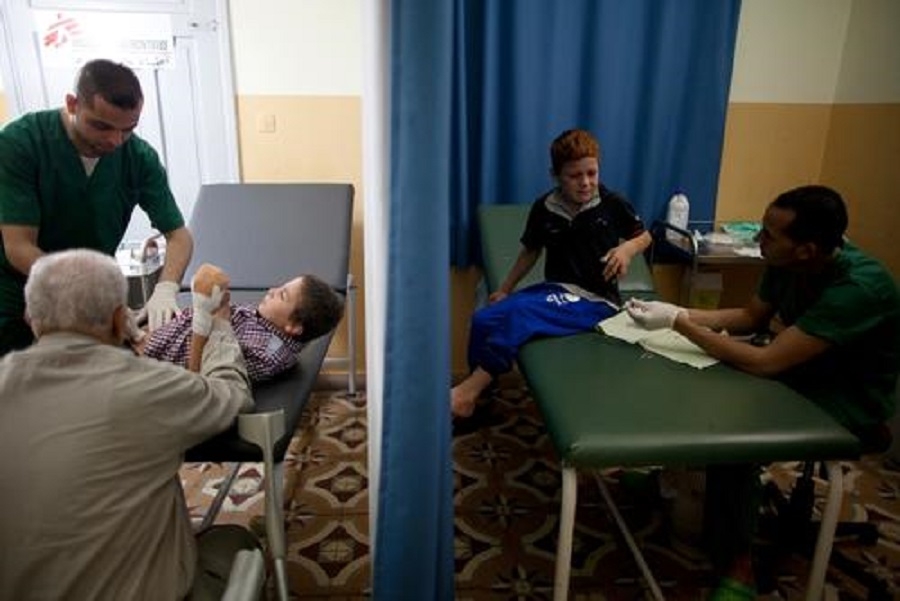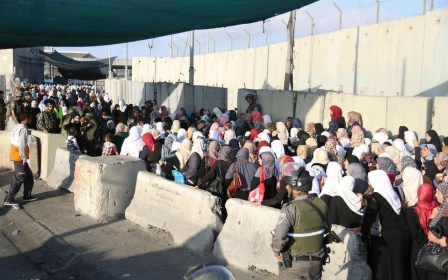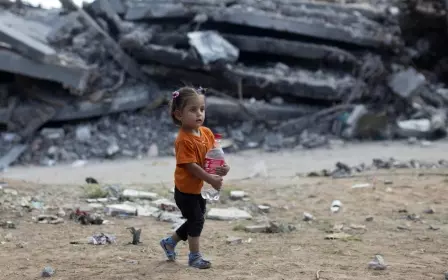Is there humanitarian complicity in the occupation of Palestine?

Stepping out of a car in the West Bank town of Kafr Qaddum, I was greeted by the stench of urine, faeces, and burned tires - a foul reminder of the near-constant confrontation between Israeli settlers and soldiers on one side, and Palestinians on the other.
The Abu Ehab family - whose two-story house is on a slope just below the road we drove in on - is caught between these battles. The family members keep their chickens on the second floor and live on the first, but the walls do little to protect them from the exchange of tear gas, burning tires and hurled rocks. The Israeli army frequently move around the Abu Ehab family’s property during nighttime search operations; at times, they enter the house.
The smell comes from “skunk,” the sewage-smelling liquid that the Israeli army uses to soak Palestinians and foreign protesters who gather weekly on this ashen road. It is so pungent that the family’s eldest son now vomits at the sight of food. The military also uses flashbang grenades to counter the demonstrations. After one detonated too close to the family’s home, the eldest daughter lost hearing in one ear.
“She used to not be able to finish a sentence without crying,” the psychologist with Médecins Sans Frontières (MSF, or Doctors Without Borders in English) who has been counselling the girl’s mother tells me. “Now, she can talk about her fears without breaking down.”
This is how MSF, as a medical humanitarian organisation, measures the progress of those we assist in the occupied Palestinian territories. For the past 15 years, our programmes in the West Bank and Gaza have focused mainly on mental health, but my colleagues at times feel like they can only give patients a thicker coat of psychological armour against the daily trauma of their lives. These patients are parents of teenagers being held in Israeli or Palestinian prisons, children with one or both parents in detention, families on the front lines of settler-Palestinian violence or intra-Palestinian violence, and those affected by nighttime Israeli army search operations or other military actions.
What our staff sees, day in and day out, are the medical consequences of the occupation. But while we can treat some of our patients’ symptoms, we can’t alter the underlying causes of their suffering. And as the suffering has become normalised, we have been questioning the wisdom of our presence. This is the humanitarian’s dilemma: how to alleviate the suffering of a population while not enabling the powers at the root of the pain.
With the one-year anniversary of the latest (but likely not the last) war in Gaza, it should be understood that humanitarian organisations do not hold a monopoly on this dilemma. All countries - the United States and European Union members in particular - that condone and help extend the occupation of the Palestinian territories, whether by subsidising it through humanitarian or military aid or by giving political cover to its policies and practices, must confront their responsibility for the suffering of Palestinians.
MSF has been working for more than 15 years in the occupied Palestinian territories. Our medical and psychological programmes give a window into the daily reality for Palestinians living in the West Bank and Gaza. It is a journey that reveals the devastation of the policies of occupation, whether through blockades and bombardments or through walls and nighttime raids.
Night terrors and bureaucratic violence
Another form of psychological violence experienced by our patients is the constant threat of loved ones being locked away indefinitely, without charge. Not far away, in the town of Majdal Bani Fadil, six children are living by themselves: Both parents were arrested in the past year, an uncle explained when I visited their home with one of our psychological assessment teams in late April. Their mother was taken away in the middle of the night 12 months ago, he told me, and says that she has been held without sentencing ever since.
The children not only saw her dragged away, but they also have no idea when she will return. Now the eldest daughter cannot focus on her studies, the middle son is prone to violent outbursts, and the middle daughter is often found crying in her parents’ old room. “They don’t have hope,” the uncle said.
MSF sees how this sort of administrative detention - through which people can be held indefinitely without charges - heightens the psychological violence inflicted on Palestinian children. As the number of Palestinians held by Israel for alleged security offenses rose by 24 percent in 2014, more and more families were separated. The number of orders for administrative detention issued by Israeli military courts in the West Bank has skyrocketed to 319 since the beginning of 2015, from 51 in 2014, according to the Palestinian Prisoners Center for Studies.
The presence of the Israeli army and its use of force are the main cause of the psychological trauma of our patients in the West Bank. A review of the main triggers resulting in our patients’ need for psychological treatment showed that just over half (52 percent) of them describe violent Israeli army search operations inside their homes, 42 percent say one or more family members is currently incarcerated, and 35 percent report being affected by indirect violence such as shootings or incursion operations by the Israeli army.
Unsurprisingly, children suffer the worst effects. Half of the 254 patients who received care in 2014 were younger than 15, and 25 percent were younger than 10. Fifty percent of the children we see say they have trouble sleeping, 34 percent report anxiety, 28 percent have trouble concentrating, and 21 percent report bed-wetting. Even our most seasoned psychologists are shocked by the levels of trauma.
Everyday struggles
Violence in parts of the West Bank is as intimate as it is predictable. I visited Hebron, in the West Bank’s south, on 23 April, when Israelis celebrated Independence Day and Palestinians commemorated the Nakba, or “catastrophe” of the forced displacement of Palestinians to create space for the new state of Israel. Settlers had draped the Israeli flag over the central mosque. The next day, a Palestinian teenager stabbed an Israeli policeman and then was killed.
After scaling a hill overlooking the old city, I met a woman, a patient at our counselling programme. Afflicted with diabetes, hypertension and poor circulation, she has been in and out of the public hospital for years. She told me how her family had lived on this hilltop for more than 70 years, staying even after a settlement was built in 1984 just beyond her front gate. In 2003, she was forbidden from using that gate.
To go to the hospital - or leave her house at all - she must use her back door and walk across a dirt path littered with trash from the settlement to reach either an ambulance or her latest beaten-up car (settlers have destroyed her five previous vehicles, she says). A trip to the market used to take five minutes; now it takes half an hour. The path floods when it rains, but the Israeli army recently told her she could no longer connect to the municipality’s sewage line.
Sadly, her daily torments are unexceptional. Some 170,000 Palestinians live in Hebron, encircled by roughly 500 Israeli settlers who are protected by several thousand Israeli soldiers stationed in a city dotted with more than 120 physical obstacles, including 18 permanently staffed checkpoints. Around 20 percent of the city has been designated as land where the Israeli army exercises full control over the freedom of movement of Palestinians.
It is a stark illustration of a stunning figure: Today, due to settlements, byways, checkpoints, and military deployments, Palestinians can only inhabit less than 40 percent of the West Bank. The shrinking space and freedom of movement for Palestinians is only expected to worsen. Plans are afoot to relocate Bedouin communities to an area north of the West Bank city of Jericho and to open a corridor stretching from East Jerusalem to the Dead Sea that would be inaccessible to Palestinians, essentially cutting the West Bank in half.
As I was leaving, the woman whose home I visited summed up the increasing surrealness of life in the Palestinian territories. “I have been to Chicago,” she whispered to our interpreter, “but never to Gaza.”
The misery of Gaza
She’s not alone. West Bank Palestinians are rarely granted permission to travel to Gaza. It’s hard to imagine they’d prefer the sense of deprivation and siege that pervades Gaza to their own, but if they were able to visit, they’d see, as I did when walking through Beit Hanoun in Gaza’s northern reaches, that it looks like last summer’s war just ended. Not a single structure that was totally destroyed by the 50-day campaign has been rebuilt.
To the extent that the war is still spoken of outside the region, much of the debate - as well as the frequent UN and human rights reports - focuses on the conduct of fighters and the nature of hostilities on both sides in 2014. These are important topics, but they shouldn’t divert attention from the ongoing misery of civilians in Gaza today.
Numbers tell part of the story of the war’s impact. Seventy-one Israelis were killed, according to the Israeli government, including five civilians. According to the UN. independent commission of inquiry into the 2014 Gaza conflict, 2,251 Palestinians were killed, including 1,462 civilians, of whom 299 were women and 551 were children. Some 11,231 Palestinians were also injured, including 3,540 women and 3,436 children.
Due to the destruction of residential buildings, 142 Palestinian families had three or more members killed in the same incident. Medical facilities, transports, and personnel in Gaza were repeatedly attacked. Seventeen hospitals, 56 primary health-care centres, and 45 ambulances were damaged or destroyed, and 16 on-duty health workers, all Palestinians, died.
The August ceasefire did not signal the end of casualties, however. On 15 May, more than 50 people were injured when unexploded ordnance blew up in the city of Beit Lahia. With nearly 7,000 unexploded bombs left in Gaza from both sides, this is likely to happen again.
Time standing still
Teetering atop half-demolished buildings, Palestinians have been reduced to scavenging rebar, copper wire, and anything else they can use from piles of wreckage. It is all valuable, given the ongoing Israeli blockade of Gaza, which was bolstered last October when Egypt closed the Rafah crossing in southern Gaza and destroyed the smuggling tunnels that ran beneath it, which had provided an economic lifeline to Gazans. The Egyptian government reopened the crossing in late June, only to close it again after three days. Materials that Israel fears would be put to military use - so-called “dual-use” materials like cement, rebar, and even wood - cannot be imported without express approval from the military. Those who try to build use sand to thicken the rare bag of cement that has gotten into Gaza.
Others have injuries from the war that require reconstructive surgery and physiotherapy. An 8-year-old girl I met in our postoperative clinic in Gaza City had lost most of the use of her extremities after shrapnel from an Israeli missile lodged in her back. All the casualty counts from the conflict are disputed, unsurprisingly, but we can see the clear preponderance of children participating in our programmes who need war-related surgeries and physiotherapy. Our backlog of reconstructive surgical cases is 300 names long.
For those who have undergone surgery, particularly amputees, physiotherapy is equally important. Whether ambulatory or using a wheelchair, they must navigate cratered streets lined with huge chunks of shattered buildings. And like the children whose screams are heard throughout our clinics as their wounds are cleaned and dressed, they must find a way to manage their pain given the ban that Hamas placed on many prescription painkillers, due to high rates of addiction in Gaza.
Why bother with hope?
The situation in Gaza today lays bare the excruciating limits of humanitarian action in the face of the occupation.
Gazans demonstrate great resilience. In May, amid the rubble, some even staged a mini “Cannes” film festival that highlighted the humanitarian crisis there and around the world. But a 10-year-old child has lived through four wars already. Another war is thought to be as inevitable as the passing seasons. With each conflict, the destruction escalates: 12,410 houses were totally destroyed in 2014, for instance, compared with 3,425 homes in 2009.
In this way, a miserable sort of normalcy has set in. Gaza’s unemployment rate has risen to 44 percent. And even though 80 percent of Gaza’s population receives some sort of aid, 40 percent of the population lives in poverty.
There is a foreboding inevitably to the rhythm of daily life. Rockets are again being tested and fired from Gaza into Israel, drawing thunderous responses from the Israelis. These violent acts - called resistance on one side and terrorism on the other - serve to reinforce the acceptance of a policy of separation and isolation of Israelis and Palestinians.
Petty crimes are on the rise, too, as the noose - man-made and natural - continues to tighten around Gaza. In less than a year, it is expected that the Mediterranean Sea will penetrate Gaza’s lone aquifer and make its water undrinkable, while Gazan fishermen are regularly strafed by the Israeli coast guard.
Tragically, all this is occurring in the absence of any meaningful progress on the political front. As a result, the international aid community - including MSF and countries like the United States and Britain - continues to subsidise the costs and propagate the tactics of the occupation. International funds underwrite the budgets of the UN Relief and Works Agency for Palestinian Refugees and private nongovernmental organisations, which together provide enough of a social safety net to, it seems, keep the suffering at an acceptable level.
Yet even this support is in jeopardy. An April analysis of aid commitments following the war, drawing on statistics released by the World Bank, revealed that only $967 million of the $3.5 billion that was promised for Gaza’s reconstruction had been delivered.
Aiding and abetting
Whether it is the nightly incursions and detentions without charges in and around Nablus, the maze of walls and checkpoints in Hebron, the partition of Jerusalem that cuts off access to medical care for Palestinian villages, or the deadly aerial bombardment and blockade in Gaza, the occupation takes many forms - all inevitably justified through a public discourse of security for Israelis.
This is a narrative accepted, enabled, and subsidised through international aid and failed peace processes. It has reduced “progress” in the Israeli-Palestinian conflict to young women who can finish sentences without crying, the number of truckloads of cement allowed to enter Gaza, or the Palestinian medical transfers facilitated through the Erez crossing.
Israeli fears of rocket fire from Gaza are evidenced in the trauma of air-raid sirens and the necessity, now part of Israeli building codes, for homes to have bomb shelters.
The ongoing threat of tunnel-enabled attacks inside Israel also precipitates anxiety among those in the areas bordering Gaza.
But these fears cannot justify the devastating medical and psychological consequences for Palestinians of the barriers, checkpoints, bombing campaigns, blockades, and incursions. These measures to protect Israelis must be examined today in terms of their humanitarian fallout. Israelis and supporters of Israel must question and confront the human costs of the policies used to achieve this security. And the governments and international institutions either explicitly or tacitly supporting these policies must do the same because the devastation they have wrought is undeniable.
Humanitarian complicity?
MSF teams in the occupied Palestinian territories and other war zones around the world are always reflecting on their actions with an eye toward ensuring that aid does not do more harm than good. For now, we will continue stitching up the physical and psychological wounds of Palestinians, knowing that another war with Israel may not be far off and that a great many people already need assistance right now.
This is our role, one constantly questioned by our medical teams on the ground, whose members are always struggling to see the invisible line between complicity with the occupation and a refusal not to ignore its consequences. Ultimately, though, our humanitarian action has been consistently justified as a response to the needs of Palestinians trapped by this endless war.
As has been the case for the past 15 years, our presence is our protest in the face of an occupation that has taken on a near-permanent character. While there is no shortage of suffering in Gaza and the West Bank, an international acceptance of the unacceptable is now the deadliest form of the occupation for Palestinians - and there is no end in sight.
- Jason Cone is the Executive Director of Doctors Without Borders/Médecins Sans Frontières (MSF) in the United States.
The views expressed in this article belong to the author and do not necessarily reflect the editorial policy of Middle East Eye.
Photo: Medical needs remain very high, especially in terms of postoperative care, rehabilitation and mental health. MSF supports the burn unit of Shifa Hospital and runs a clinic postoperative care in central Gaza. (Joao Laet)
An earlier version of this article was published on Médecins Sans Frontières’ website on 7 July, 2015.
New MEE newsletter: Jerusalem Dispatch
Sign up to get the latest insights and analysis on Israel-Palestine, alongside Turkey Unpacked and other MEE newsletters
Middle East Eye delivers independent and unrivalled coverage and analysis of the Middle East, North Africa and beyond. To learn more about republishing this content and the associated fees, please fill out this form. More about MEE can be found here.





